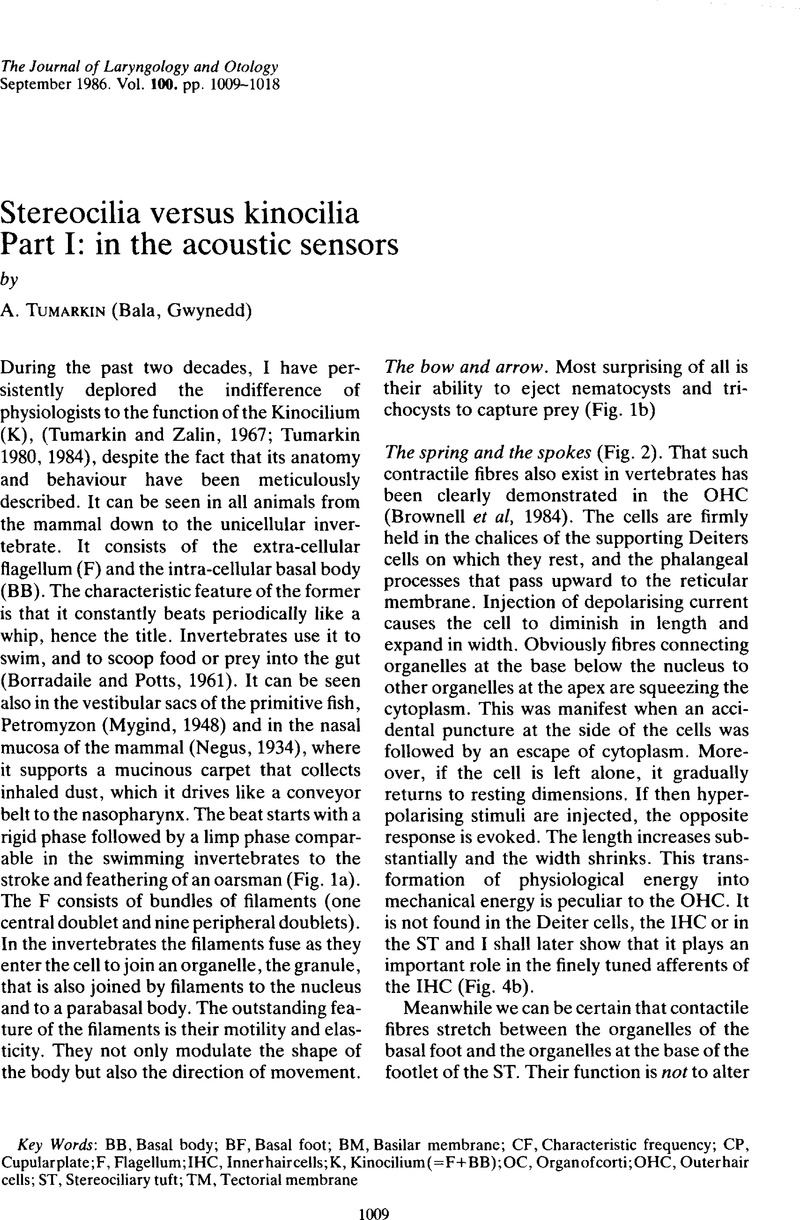No CrossRef data available.
Article contents
Stereocilia versus kinocilia Part I: in the acoustic sensors
Published online by Cambridge University Press: 29 June 2007
Abstract
An abstract is not available for this content so a preview has been provided. Please use the Get access link above for information on how to access this content.

- Type
- Research Article
- Information
- Copyright
- Copyright © JLO (1984) Limited 1986
References
Ashmore, J. F. and Russell, I. J. (1983) The Physiology of hair cells (Ed. Lewis, B. R.) London. Academic Press, pp. 149–180.Google Scholar
Borradaile, L. A. and Potts, F. A. (1961) The invertebrata. Cambridge University Press.Google Scholar
Brownell, W. E., Bader, C. R. and Bertrand, D. (1984) Evoked mechanical responses of isolated cochlear outer hair cells. Science, 223: 194–196.Google Scholar
Crawford, A. C. and Fettiplace, R. (1980) Frequency selectivity of auditory fibres and hair cells in the cochlea of the turtle. Journal of Physiology, 306: 79–105.CrossRefGoogle ScholarPubMed
Crawford, A. C. and Fettiplace, R. (1981) Non linearities in the responses of turtle hair cells. Journal of Physiology, 315: 317–338.CrossRefGoogle Scholar
Dallos, P., Ryan, D. and Ozdamar, O. (1977) Cochlear frequency selectivity in presence of hair cell damage. In Psycho physics and Physiology of Hearing (Eds. Evans, E. F. and Wilson, J. P.) Academic Press, London, pp. 249–258.Google Scholar
Flock, A., Bretcher, A. and Weber, K. (1982) Immuno histo chemical localisation of several Cyto Skeletal Proteins in the inner ear sensory and supporting cells. Hearing Research, 6: 75–89.CrossRefGoogle Scholar
Gernandt, B. E. (1967) Vestibular influence on spinal activity in Myotatic and Vestibular mechanisms. Ciba Foundation Symposium, pp. 170–204.Google Scholar
Holton, Y. and Weiss, T. F. (1983) Frequency selectivity of hair cells and nerve fibres in the Alligator Lizard cochlea. Journal of Physiology 345: 241–260.CrossRefGoogle Scholar
Jeffress, L. A. (1948) A place theory of sound localisation. Journal of Comparative Physiology and Psychology, 41: 35–39.CrossRefGoogle Scholar
Kohlloffel, W. E. (1973) Observations of the mechanical disturbances along the basilar membrane with laser illumination. In Basic mechanics in hearing (Ed. Moller, A. R.) 11, 95–113.CrossRefGoogle Scholar
Koshigo, S. and Tubis, A. (1982) Investigation of cochlear stability in presence of negative damping. In Journal of the Acoustic Society of America, Supplement 1, 71: 17.CrossRefGoogle Scholar
Lighthill, J. (1981) Energy flow in the cochlea. Journal of Fluid Menchanics, 106: 149–213.CrossRefGoogle Scholar
Manley, C. A. (1977) Interactions between hair cells. In Psycho-physics and Physiology of Hearing (Eds. Evans, E. F. and Wilson, J. P.) Academic Press, London pp. 139–146.Google Scholar
Mygind, S. M. (1948) The problem of the Petromyzon Labyrinth. In Practica Oto, Rhino, Laryngologica Vol X Fasc 1/2.Google Scholar
Neeley, S. T. and Kim, D. O. (1982) An active model for sharp tuning and high sensitivity in cochlear mechanics. Journal of the Acoustical Society of America. Supplement 1, 71: 16–17.CrossRefGoogle Scholar
Negus, V. E. (1934) The Comparative anatomy and Physiology of the Nose and Paranasal Sinuses. Livingstone, London and Edinburgh. 402 pages.Google Scholar
Noble, D. (1975) The Initiation of the heart-beat. Oxford University Press, Ely House, London156 pages.Google Scholar
Rhode, W. S. (1971) Observation of the vibration of the basilar membrane in squirrel monkeys, using the Mossbauer technique. Journal of the Acoustical Society of America, 49: 1218–1231.CrossRefGoogle ScholarPubMed
Rhode, W. S. (1973) An investigation of post-mortem cochlear mechanics, using the Mossbauer effect. In Basic mechanisms in hearing (Ed. Moller, A. R.) pp. 49–63.CrossRefGoogle Scholar
Spoendlin, H. (1979) Sensory neural organisation of the cochlea. Journal of Laryngology and Otology, 93: 853–877.CrossRefGoogle ScholarPubMed
Tilney, L. G. and Mulroy, M. J. (1980) The organisation of Actin filaments in the stereocilia of cochlear hair cells. Journal of Cell Biology, 86: 244–259.CrossRefGoogle ScholarPubMed
Tumarkin, A. (1979) A new theory of cochlear function. Part II British Journal of Audiology, 13: 15–18.CrossRefGoogle Scholar
Tumarkin, A. (1980) The Controversial Cupula and the enigmatic Kinocilium. Journal of Laryngology and Otology, 94: 917–927.CrossRefGoogle ScholarPubMed
Tumarkin, A. (1982) Bimodal hearing, the controversial second filter and the mystery of the missing O.H.C. afferents. Journal of Laryngology and Otology, 96: 297–308.CrossRefGoogle Scholar
Tumarkin, A. (1984) Multi modal hearing, the fundamental importance of the Kinociliary servo mechanism and the folly of Psycho acoustics.CrossRefGoogle Scholar
Tumarkin, A. (1984) Part 1 The struggle for power and the anthropocentric obsession. Journal of Laryngology and Otology, 98: 557–566.CrossRefGoogle Scholar
Tumarkin, A. (1984) Part 2 The garrulous fish and the unemployed Kinocilium. Journal of Laryngology and Otology, 98: 659–670.CrossRefGoogle Scholar
Tumarkin, A. (1984) Part 3 Physiologists try to capture the unknowable in a net of mathematical equations. Journal of Laryngology and Otology, 98: 747–757.CrossRefGoogle Scholar
Tumarkin, A. and Zalin, H. (1967) The function of the Kinocilia and Stereocilia. Journal of Laryngology and Otology, 81: 119–135.Google Scholar
Webster, D. B. (1971) The ear apparatus of the Kangaroo rat. American Journal of Anatomy, 108: 123–148.CrossRefGoogle Scholar
Zwislocki, J. J. (1977) Further indirect evidence for interaction between cochlear inner and outer hair cell. In Psycho physics and Physiology of Hearing (Eds. Evans, E. F. and Wilson, J. P.) Academic Press, London. pp.125–136.Google Scholar




